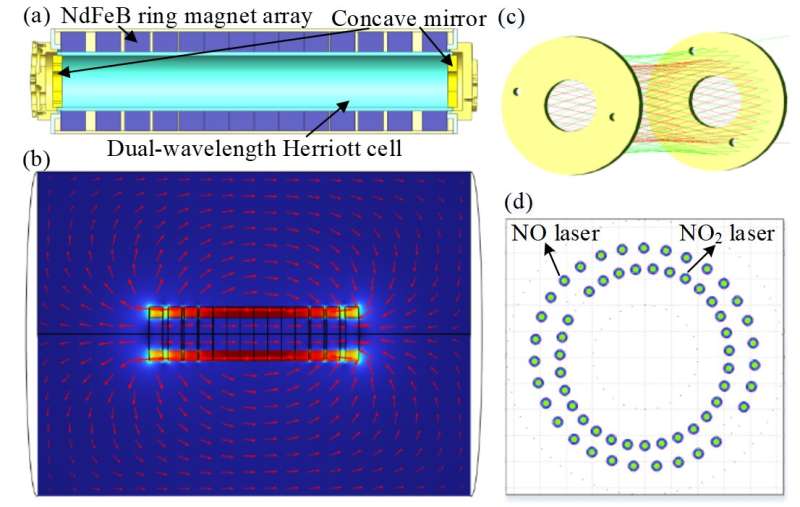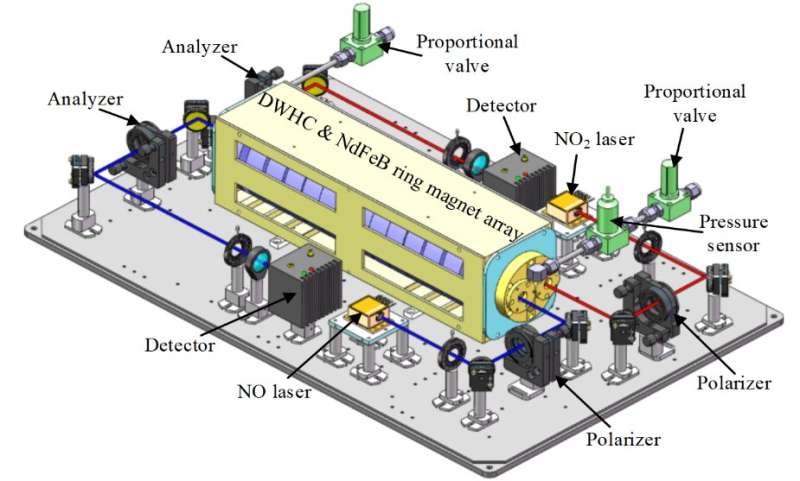This article has been reviewed according to Science X's editorial process and policies. Editors have highlighted the following attributes while ensuring the content's credibility:
fact-checked
proofread
Novel Faraday rotation spectroscopy sensor enables simultaneous two-component detection of nitrogen oxides

A research team led by Prof. Gao Xiaoming at the Anhui Institute of Optics and Fine Mechanics (AIOFM), Hefei Institutes of Physical Science (HFIPS) of Chinese Academy of Sciences (CAS) recently proposed a new dual-wavelength Faraday rotation spectroscopy (FRS) sensor in the two-component simultaneous detection of nitrogen oxides.
Related research result was published in Sensors and Actuators: B. Chemical.
Nitrogen oxides are at the center of atmospheric chemical reactions and influence the concentration of ozone, hydroxyl and peroxy radicals, which are important precursors for the formation of photochemical smog, acid rain and haze pollution. At the same time, nitrogen oxides emitted by agricultural fields, wetlands and other ecosystems play an important role in the global nitrogen cycle.
In this research, Prof. Liu Kun and Cao Yuan et al. proposed a two-component simultaneous detection sensor for nitrogen oxides with static magnetic field FRS based on NdFeB ring magnet array in response to the problems of slow measurement rate and lack of selectivity for nitric oxide and nitrogen dioxide in traditional chemiluminescence detection of nitrogen oxides.
The interaction between two beams of linearly polarized light of different wavelengths and nitrogen oxides in a static magnetic field was facilitated by designing a single-cavity, dual-optical path gas absorption cell and coupling it coaxially to a NdFeB ring magnet array.

Aside from that, they recommended that the absorption cell should be less than or equal to the length of permanent magnet ring array. This is to address the issue that the left and right sides of NdFeB ring magnetic array were opposite to the direction of internal axial magnetic field, causing partial cancelation of the magneto-optical signal excited by internal axial magnetic field.
By combining wavelength modulation spectroscopy with a static magnetic field, the FRS NOx sensor achieved a detection sensitivity of 0.58 ppb NO2 and 0.95 ppb NO over an optical length of 23.7 m and an integration time of 100s.
This work lays the foundation for further developing eddy covariance method-based studies of the soil-plant-atmosphere NOx interface fluxes in ecosystems.
More information: Yuan Cao et al, Dual mid-infrared wavelength Faraday rotation spectroscopy NOx sensor based on NdFeB ring magnet array, Sensors and Actuators B: Chemical (2023). DOI: 10.1016/j.snb.2023.133805
Provided by Hefei Institutes of Physical Science, Chinese Academy of Sciences





















